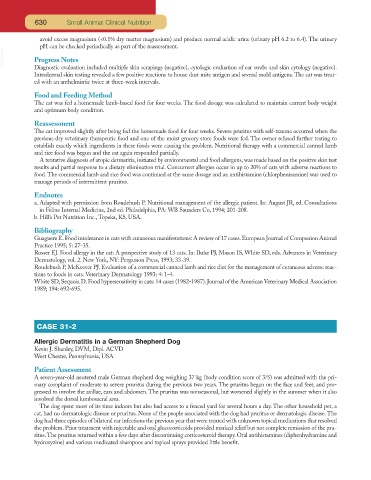Page 608 - Small Animal Clinical Nutrition 5th Edition
P. 608
630 Small Animal Clinical Nutrition
avoid excess magnesium (<0.1% dry matter magnesium) and produce normal acidic urine (urinary pH 6.2 to 6.4). The urinary
pH can be checked periodically as part of the reassessment.
VetBooks.ir Progress Notes
Diagnostic evaluation included multiple skin scrapings (negative), cytologic evaluation of ear swabs and skin cytology (negative).
Intradermal skin testing revealed a few positive reactions to house dust mite antigen and several mold antigens. The cat was treat-
ed with an anthelmintic twice at three-week intervals.
Food and Feeding Method
The cat was fed a homemade lamb-based food for four weeks. The food dosage was calculated to maintain current body weight
and optimum body condition.
Reassessment
The cat improved slightly after being fed the homemade food for four weeks. Severe pruritus with self-trauma occurred when the
previous dry veterinary therapeutic food and one of the moist grocery store foods were fed. The owner refused further testing to
establish exactly which ingredients in these foods were causing the problem. Nutritional therapy with a commercial canned lamb
and rice food was begun and the cat again responded partially.
A tentative diagnosis of atopic dermatitis, initiated by environmental and food allergens, was made based on the positive skin test
results and partial response to a dietary elimination trial. Concurrent allergies occur in up to 20% of cats with adverse reactions to
food. The commercial lamb and rice food was continued at the same dosage and an antihistamine (chlorpheniramine) was used to
manage periods of intermittent pruritus.
Endnotes
a. Adapted with permission from Roudebush P. Nutritional management of the allergic patient. In: August JR, ed. Consultations
in Feline Internal Medicine, 2nd ed. Philadelphia, PA: WB Saunders Co, 1994; 201-208.
b. Hill’s Pet Nutrition Inc., Topeka, KS, USA.
Bibliography
Guaguere E. Food intolerance in cats with cutaneous manifestations: A review of 17 cases. European Journal of Companion Animal
Practice 1995; 5: 27-35.
Rosser EJ. Food allergy in the cat: A prospective study of 13 cats. In: Ihrke PJ, Mason IS, White SD, eds. Advances in Veterinary
Dermatology, vol. 2. New York, NY: Pergamon Press, 1993; 33-39.
Roudebush P, McKeever PJ. Evaluation of a commercial canned lamb and rice diet for the management of cutaneous adverse reac-
tions to foods in cats. Veterinary Dermatology 1993; 4: 1-4.
White SD,Sequoia D.Food hypersensitivity in cats: 14 cases (1982-1987).Journal of the American Veterinary Medical Association
1989; 194: 692-695.
CASE 31-2
Allergic Dermatitis in a German Shepherd Dog
Kevin J. Shanley, DVM, Dipl. ACVD
West Chester, Pennsylvania, USA
Patient Assessment
A seven-year-old neutered male German shepherd dog weighing 37 kg (body condition score of 3/5) was admitted with the pri-
mary complaint of moderate to severe pruritus during the previous two years. The pruritus began on the face and feet, and pro-
gressed to involve the axillae, ears and abdomen. The pruritus was nonseasonal, but worsened slightly in the summer when it also
involved the dorsal lumbosacral area.
The dog spent most of its time indoors but also had access to a fenced yard for several hours a day. The other household pet, a
cat, had no dermatologic disease or pruritus. None of the people associated with the dog had pruritus or dermatologic disease.The
dog had three episodes of bilateral ear infections the previous year that were treated with unknown topical medications that resolved
the problem. Prior treatment with injectable and oral glucocorticoids provided marked relief but not complete remission of the pru-
ritus.The pruritus returned within a few days after discontinuing corticosteroid therapy. Oral antihistamines (diphenhydramine and
hydroxyzine) and various medicated shampoos and topical sprays provided little benefit.

